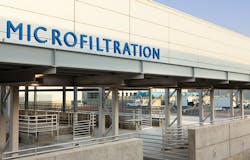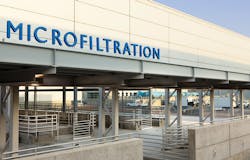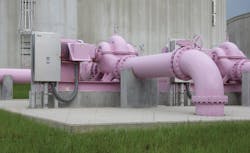By Lori Anne Dolqueist
Recycled water is former wastewater that is treated to remove solids and impurities. The treatment of recycled water depends on its source and how it will be used once treated. It can be used for a variety of purposes, including irrigating landscape, recharging groundwater aquifers, meeting commercial and industrial water needs, and even for drinking.
Since it is reused instead of discharged, recycled water furthers the goals of sustainability and conservation. It can be used to reduce the need for additional potable water supplies and to diminish the severity of water rationing during periods of drought.
This summer, California municipalities in particular are feeling the pressure. On April 1, Governor Jerry Brown ordered a statewide 25-percent reduction in potable urban water usage (as compared to 2013 usage levels). The established reduction levels vary by community and range from as low as 4 percent to as high as 32 percent. In California, many municipalities are turning to recycled water to meet mandated conservation goals. For others, recycled water projects are part of creating a more resilient water supply.
Although recent drought conditions throughout the west have thrust recycled water into the spotlight, its use is not new. As early as the 1920s and 30s, the cities of Los Angeles and San Francisco used reclaimed water for landscape irrigation in parks. As the cost of potable water increases and the availability of once-abundant water supplies decreases, more municipalities across the country are looking to include recycled water as part of their water portfolios.
Perhaps the most obvious use for recycled water -- and the most widely accepted -- is landscape irrigation. In times of scarcity, it is difficult to justify the use of potable water for decorative purposes in parks, medians and other large landscaped areas. Although such use may not be considered "essential," this type of landscaping is important: it impacts property values, quality of life, and public use and enjoyment of such spaces.
Recycled water used for landscape irrigation is treated but not to a "potable" level; it can be safely used to irrigate turf and most plants. Indeed, recycled water often contains higher levels of nutrients such as nitrogen and phosphorus that help meet the fertilizer needs of the landscape. But, recycled water often has higher levels of dissolved salts as well, so it is important to develop strategies to address this issue in order to avoid harm to the landscape.
Golf courses -- which consume large amounts of water -- have begun embracing the use of recycled water, particularly in the arid west and southwest. With their lush, rolling greens, golf courses can be easy targets for "drought shaming," so switching over to recycled water can help avoid negative public perception. Additionally, as the cost of potable water increases, it simply may not be financially feasible to continue to use it for golf course irrigation.
Another use for recycled water is to recharge groundwater basins, a use that dates back to the early 20th century in the United States. As with the use of recycled water for irrigation, however, water supply constraints are making groundwater recharge and storage an increasingly attractive option as it allows water providers to meet water needs in the face of increased demand and diminished (or prohibitively expensive) supply.
Wastewater slated for groundwater recharge is first treated at water reclamation plants and the resulting product typically meets the standards for drinking water. This treated water is placed into the ground via recharge ponds or injection wells, where it may receive additional geopurification treatment. As the recycled water moves through the aquifers, it mixes with other groundwater and goes through a natural purification process. It can then be pumped out of production wells and used to serve customers.
As existing aquifers become increasingly overdrawn to meet urban, agricultural, commercial, and industrial needs, groundwater recharge using recycled water provides a way to potentially reverse some of the damage caused by over-pumping. In some cases, these recharged aquifers may also be used to store water for future use.
The last -- and most controversial -- use of recycled water is for drinking water. The unfortunate and off-putting "toilet-to-tap" moniker has for decades hampered efforts to use recycled water for consumption. California's pioneering Orange County Water District wastewater treatment facility, for example, recycles used water and returns it to the general drinking water supply. Although Orange County began using recycled water for non-potable uses in the 1970s, it did not include it as part of the drinking water supply until 2008, after an exhaustive public outreach and educational campaign to address customer concerns.
In Orange County, the water is processed using a three-step indirect potable reuse process. The first step is microfiltration of the treated wastewater to remove solids, bacteria and impurities. Next, the water goes through reverse osmosis, as it is pushed through a fine membrane that filters out viruses and pharmaceuticals. Last, the water is treated with ultraviolet light to remove any remaining organic compounds before it is deposited into the main groundwater supply, which must meet strict safety and health standards before it is distributed to customer households.
In May 2013, the first direct potable reuse water facility in the U.S. went online in Big Spring, Texas. With direct potable reuse, treated wastewater is reused as drinking water without an environmental buffer. In other words, recycled water is sent to the final treatment plant without passing it through groundwater reserves (as is done in Orange County, for example). Like Orange County, the Big Spring plant treats the water using microfiltration, reverse osmosis and ultraviolet disinfection. Instead of passing through the groundwater supply, however, the treated water is combined with raw water from an area lake and distributed to multiple regional facilities where it is treated again using conventional drinking water techniques before distribution to customers.
A year after the Big Spring facility began serving customers, a second direct potable reuse facility opened in Wichita Falls, Texas.
While there were pockets of opposition in each of these cases, the transition to using recycled water as part of the overall drinking water supply appears to be going smoothly, according to most reports.
As water supply constraints reach crisis proportions in some areas of the U.S., consumers seem willing to reconsider their aversion to drinking recycled water. Indeed, research has shown that emphasizing the need for recycled water and its benefits to the community can shift popular opinion. In fact, many communities throughout the country are currently exploring the possibility of using recycled water for drinking water purposes, either through direct or indirect potable reuse.
As the use of recycled water grows throughout the country, what was once considered a liability is now a potential source of revenue and opportunity. Rather than taking on the regulatory and environmental burdens associated with discharge, communities may find that they have multiple entities interested in their wastewater. As public opinion shifts and technology improves, recycled water will become an increasingly attractive option for communities across the country.
About the Author: Lori Anne Dolqueist is a partner in the Energy, Environment & Natural Resources practice of Manatt, Phelps & Phillips and is based in the San Francisco office. She is an expert in California utility regulatory matters, with particular focus on matters involving water utilities. Dolqueist can be reached at (415) 291-7452 or [email protected].





